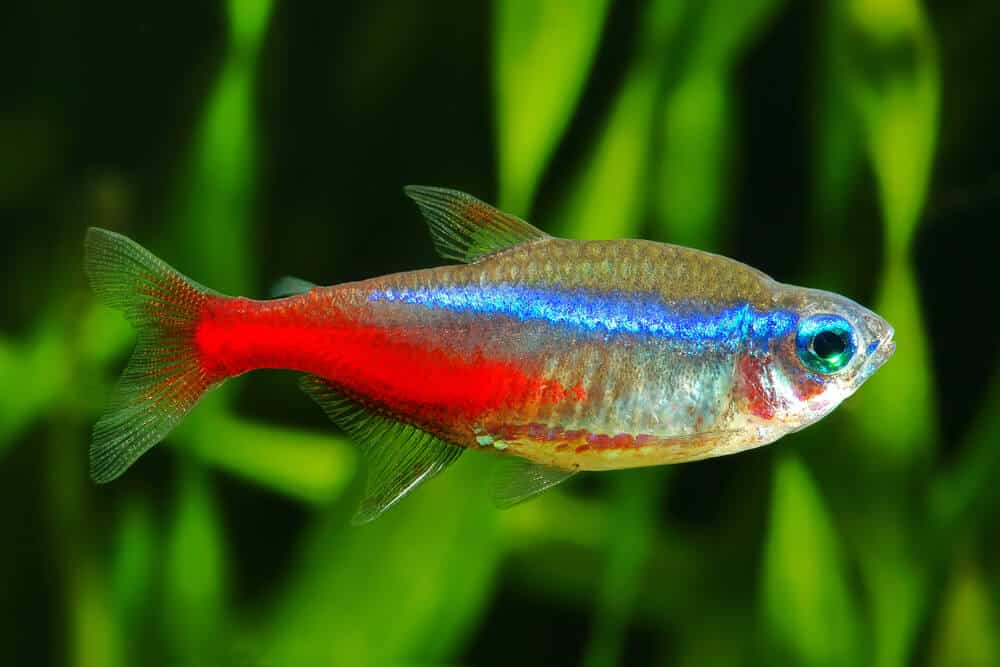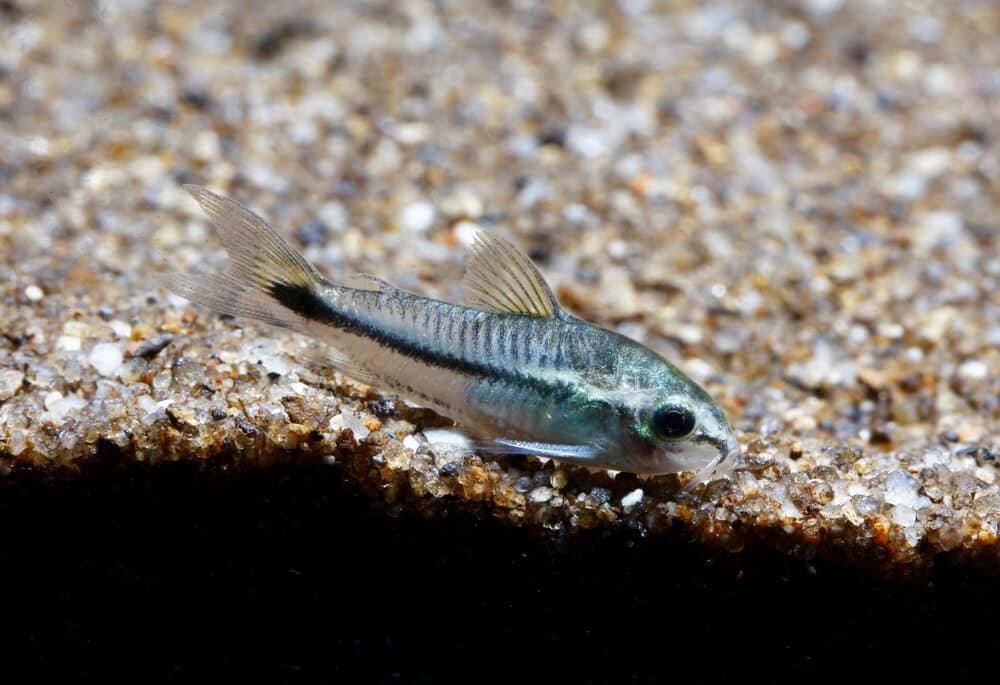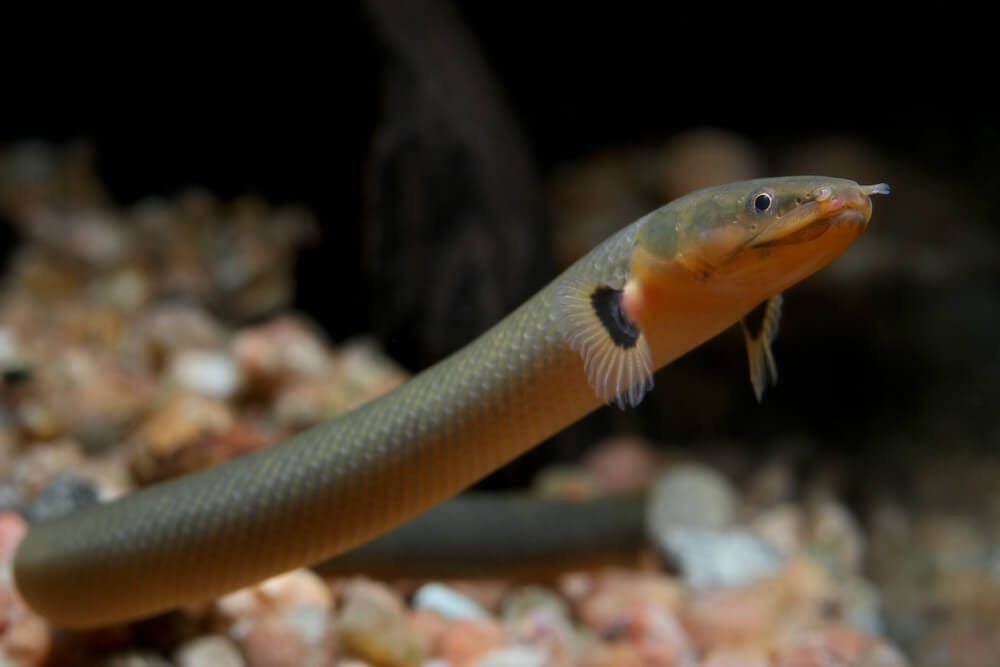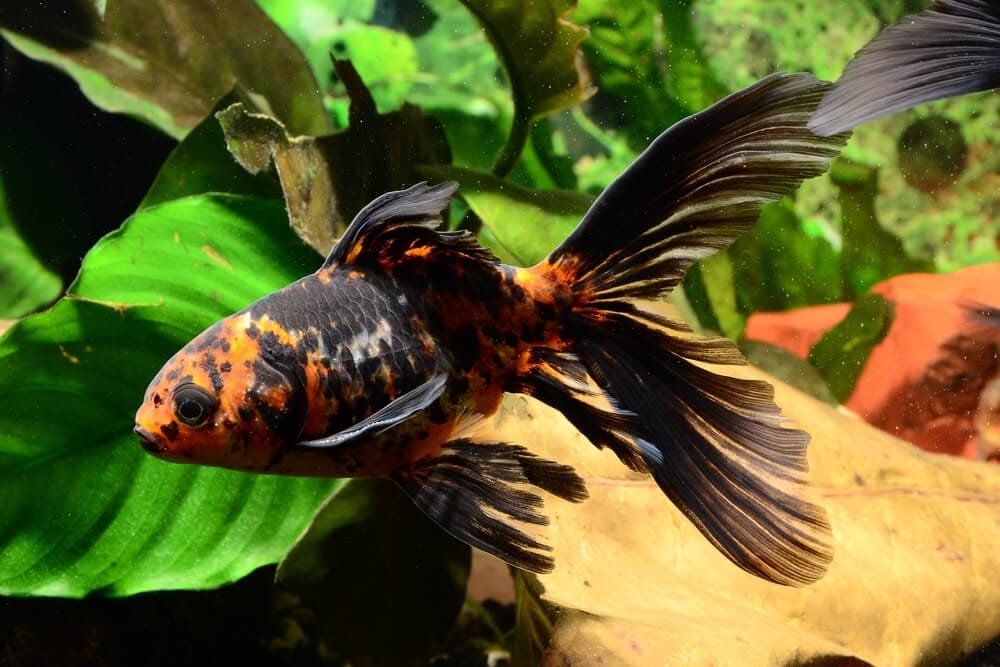Neon Tetra School Size – What You Need To Know About This Stunning Fish Species

Neon Tetras have become many people’s favorite pet fish because of their stunning and intriguing colors of a silver-white abdomen and a light-blue back. However, if you want the fish to thrive, you must find the proper Neon Tetra school size.
So, how many of these fish should you keep in school?
Neon Tetras are schooling fish, so they will thrive longer with more companions. They will feel safe with a minimum of six companions but will be happier if you add more.
You also need to keep the tank’s water at a minimum of 10 gallons. However, you must add more water the more Neon Tetras you have in the tank.
More About The Neon Tetra School Size
Neon Tetras are among the popular choices for hobbyists who want to add a dash of color to their tanks. Before getting them, remember that they will be happier and live longer if they have a handful of buddies in the tank.
The minimum number of Tetras in a tank is six, but you must add more within two to three weeks because the fish will thrive longer when they can follow a crowd.
Some hobbyists also recommend starting with 15 to 20 Neon Tetras instead of six. In this case, the water tank has to be kept at a minimum of 20 gallons.
Additionally, you must not leave Neon Tetras alone in a tank. They need to live in groups to thrive since the fish is pretty social.
Never keep the fish alone since it can put its health at risk. A lonely fish is always insecure and uncomfortable in a certain setting. Loneliness can leave a Neon Tetra feeling stressed, which can cause death.
When your fish gets sick, it is recommended that you immediately separate it from the school. However, you should not keep the fish alone for an extended period to avoid aggravating the infection.
Instead, try to seek immediate medical attention, so you can return the fish to its community as soon as the disease is contained.
The More Neon Tetras, The Bigger The Tank
Neon tetras love swimming, so you must keep them in a large tank that will allow them to swim freely. A large tank will also come in handy once the fish have grown to adult sizes.
A tank that holds less than six gallons of water is not ideal as it tends to constrict the movement of the fish. So, the perfect size would be a 10-gallon tank, which can hold around six Neon Tetras.
If you want to increase the quantity of your fish to around 10 to 13, then opt for a 20-gallon tank. This will eradicate overcrowding problems and maximize swimming space.
In addition, you can host other small, non-aggressive freshwater fish like betta or any other school of species.
Why is it important to choose the right size of tanks for your Tetras?
One, the Neon Tetra school size largely depends on the tank size. Perfect tank size can give your fish numerous benefits that can help accelerate growth and survival.
Some of these benefits include the following:
- Maximizes movement space
Healthy Neon Tetras love to swim around, so an appropriate tank will allow them to move around freely without any restrictions. Thereby, it is recommended that you use huge tanks, in case you are considering keeping them in large groups.
A spacious tank will allow the fish to explore every corner of the tank and inhibit vast growth.
- Encourages easy breeding
Using an appropriate tank during the breeding season would be more effective since Neon Tetras are adapted to reproduce in spacious environments like streams and rivers. This means that a larger tank will help them multiply easily.
However, you can still use a small tank that can hold at least six to eight gallons of water. This becomes easier since each fish needs to breed in a separate tank.
- Eradicates harmful substances
You will often find a lot of dirt and fluctuating parameters in a small tank with numerous fish.
On the other hand, if you have an ideal tank, you can prevent the generation of toxic materials and chemical imbalance. This will allow the Neon Tetra to have a longer lifespan.
- Leaves room for other species
Neon tetras are very social and feel incredibly comfortable while living with other species. Therefore, it is recommended that you add similar-sized, non-aggressive, and colorful fishes like corydoras, barbs, dwarf gouramis, and more.
- Keeps your fish safe
An ideal tank will allow you to include various decorations and plants. They will enable the fish to live in a safe place by mostly hiding from predators or enemies in the tank.
More About The Nature Of Neon Tetras
A Neon Tetra is a freshwater fish native to the Amazon basin of South America. Territories around the Amazon basin usually possess clearwater and blackwater streams, which contain low levels of dissolved solids and conductivity.
Due to their bright-colored features, these tropical fish can easily be spotted even in blackwater streams, which is why they are widely kept by many worldwide. You can easily recognize a Neon Tetra by looking at the colors on its back and abdomen, which are light blue and silver-white, respectively.
However, this type of fish is almost transparent apart from the iridescent blue and red stripes. In this case, the stripes change color as soon as the angle of view is interfered with.
The males and females of these species usually show different features, also known as sexual dimorphism. For instance, a female will contain a bent iridescent stripe while a male will have a straight one.
The blue and red stripes turn black or gray when the fish is inactive or while resting. This behavior is usually influenced by guanine crystals, which occur whenever the lighting conditions are changed.
Here are the basic factors you need to know about the fish to understand them better:
1. Diet
Neon Tetras are omnivorous, meaning they feed on both animal and plant materials. Their diet includes live or frozen brine shrimp, tiny granules, frozen bloodworms, daphnia, and flake food. If you plan to keep these fish, try to include live foods in their diet for healthy consumption.
In the wilderness, Neon Tetras feed on an aquatic matter like algae, floating detritus, and microorganisms. However, their diet is somewhat restrictive due to their small size. Therefore, ensure you offer them enough food to avoid wastage.
2. Reproduction
When it comes to the reproduction process, Neon Tetra has become a quite fascinating species. In the wild, the females can lay up to 100 eggs immediately after the rainy season.
Afterward, the male needs to fertilize the eggs before sticking to particular vegetation. It will take around one day for the eggs to hatch. The young ones, commonly referred to as fry, do not receive parental guidance.
3. Breeding at home aquariums
It’s a different scenario for Neon Tetras kept at home aquariums. You have to breed them, which can be difficult, considering that you have to provide them with appropriate water conditions.
If you want to try your hands at breeding your Neon Tetras, here are the steps to get this done:
- Step 1: Prepare the breeding tank
Choose an appropriate breeding tank. However, if you want to breed more than one fish, always ensure you use a separate tank for each one.
- Step 2: Add water to the tank
After choosing a suitable tank, add water with a hardness of one to two dGH and a PH of around 5.0-6.0.
- Step 3: Cover the tank
Most fish tend to jump out during spawning, so try to find a good cover. Moreover, always use dark paper to cover the sides of the tank to minimize the amount of light.
Occasionally, it is encouraged that you begin breeding without lighting and then increase it gradually.
- Additional Information
You should always keep the water temperature at around 72 to 75 degrees Fahrenheit. Furthermore, include live foods before transferring the fish to a breeding tank.
Proper Caring Tips Of Neon Tetras
Caring for a large Neon Tetra school size is simple even to beginners. You only need to provide them with a healthy and comfortable environment, almost like their native home.
In this case, check out the following requirements for the tank.
1. Size
Typically, a large group of neon tetras needs to live in a large-sized tank. The minimum you can use is a ten-gallon tank that can hold around six Neon Tetras. If you wish to add more fish, you should add at least two gallons of water for every fish you add.
2. Mimicking elements
Neon tetras originate from tropical environments around the Amazon Basins of South America. Thus, it is essential to include various things that help the fish transition and cope with aquarium life.
These fish are mostly surrounded by vegetation growing in water streams in the wild.
So, add plants, caves, and artificial rocks to the tank where they can hide, rest peacefully, and feel more secure. Moreover, keep the environment darker by adding black sand or aquarium soil.
3. Temperature requirements
Neon Tetras prefer moderate water temperature, never too high or too low. Maintaining the water temperature at 68 to 80 degrees Fahrenheit is best.
Not doing so may result in an uncomfortable environment that will stress the fish and likely reduce its lifespan.
4. Water requirements
The right amount of water is essential for your fish’s survival. So, try to use appropriate parameters that perfectly suit a certain group of Neon Tetras.
Furthermore, use soft water with a PH level of around 6.0 to 7.0.
5. Lighting levels
Neon Tetras love living in darker environments. So, it is important to limit the tank’s lighting levels. Use two watts of lighting to help balance darkness while providing suitable illumination.
6. Good Filtration System
A good filtration system helps eradicate any toxic and dirt particles in the water. This is essential, especially if you possess a large group of fish.
Proper filtration helps the fish live comfortably and healthily. Therefore, try to clean and change the water more often to avoid wastage of fish.
Health And Common Sicknesses Of Neon Tetra
A Neon Tetra school size of more than six tends to cause transmission of diseases. Therefore, you should immediately separate a sick fish as soon as you notice any sign.
However, keeping the fish alone for too long is not recommended since they tend to feel lonely easily, which may worsen the disease.
Similar to how humans receive medical care, Neon Tetras also need to receive appropriate attention whenever they get sick.
After separating them, try to follow all the requirements for their survival while providing them with a proper diet and medication.
Types Of Neon Tetras Diseases
Two types of deadly diseases commonly affect Neon Tetras: the Neon Tetra disease and False Neon disease.
· Neon Tetra Disease
Neon tetras occasionally get affected by a deadly disease, commonly referred to as Neon Tetra disease (NTD). The condition occurs when the fish eats infected matter like dead fish.
Moreover, a particular fish in a Neon Tetra school can also pass this disease to other healthy tetras.
The disease can become a major problem in most cases since it is usually deadly and incurable. Thus, you should immediately seek medical attention once you notice any symptoms of this disease.
Its symptoms include discoloration, uneasy swimming, fatigue, visible lumps on the body, and a curved spine. The fish can start showing signs of bloating and fin rot when the disease develops.
· False Neon Disease
This disease exhibits similar symptoms to those of NTD. Most people cannot tell the difference until laboratory research is done.
However, the false neon disease is mainly caused by bacteria brought about by using dirty water.
To treat the fish, remove it from the tank before it affects the other fish. Treat the fish using a medication cocktail or fish baths.
Alternatively, you can use a diatom filter to rid any parasitic particles in the tank. Ensure you follow various prevention measures to help your fish stay healthier and increase its lifespan.
Neon Tetra Tank Mates
You have many options for the tank mates suited for your Neon Tetras. They are tiny, so avoid larger fish that can bully or eat them.
However, you can choose from any of the following small community fish species to add to your tank along with your Tetras:
1. Zebra Danios
Size: 2 inches
Min. Tank Size: 20 gallons
Temperament: Peaceful schooling fish
Diet: Omnivorous
Care Level: Easy
They are docile, similar to the tetras, making a good combination. However, the two species slightly vary in their water requirements.
The tetras thrive in warm water and will find it hard to digest food when the temperature goes below 75 to 80 degrees Fahrenheit.
On the other hand, Zebra Danios prefer water temperatures between 65 to 75 degrees Fahrenheit. But they can easily adjust to the changes and still thrive happily and healthy when placed in the same tank as the tetras.
Additionally, both fish species love having many greeneries in the tank. They also eat almost the same things, so feeding and caring won’t be much hassle.
If you place the two species in the same tank, the ideal numbers are six of each kind. Having less than six of each species will trigger stress, resulting in the fish becoming aggressive since they will feel threatened and unsafe.
2. Harlequin Rasboras
Size: 2 inches
Min. Tank Size: 20 gallons
Temperament: Peaceful schooling fish
Diet: Omnivorous
Care Level: Easy
Harlequin Rasboras looks dusky with pinkish and orange hues. They have chops at each side of their bodies or what appear to be triangle patches.
They may be slightly bigger than tetras, but they make good companions. Both species are non-aggressive and can thrive with almost the same water parameters and diet.
You can give them the same food, a combination of animal and plant matters. You also have to feed them live food or live food that was frozen and thawed.
3. Guppies
Size: 2 inches
Min. Tank Size: 10 gallons
Temperament: Peaceful, active shoaling fish
Diet: Omnivorous
Care Level: Easy
Guppies are quite peaceful, which is why they often get bullied by the wrong tank mates. It is rare for them to become aggressive to other fish.
However, male guppies behave aggressively toward the same species when there’s a lack of female guppies in the tank.
To reduce the occurrence of aggression, you should put one male guppy for every two female guppies. Breeding is common to this species, so it is possible to have more guppies in the tank than you intended.
When you have both the tetras and guppies in the same tank, you have to design the habitat to benefit both kinds. Keep each fish species in a shoal or school and never on its own.
They have the same diet, so you can feed them with a mix of plant and meat matter. You should also add live food, such as daphnia and mosquito larva.
Both species will continue eating when there’s food, so be careful since overfeeding will make them sick. It is best to feed them twice a day.
Frequently Asked Questions
What is the average lifespan of Neon Tetras?
As long as you provide Neon Tetras with the right conditions and meet all the requirements, they can live up to five or ten years. However, remember that this period will only be possible if you gain essential knowledge about how to provide better care for your tetras.
On the other hand, neglecting them for long periods will lead to inevitable consequences like diseases or even death.
Which tank mates should I include in Neon Tetras tanks?
Neon Tetras can stay peaceful and happy with other small and non-aggressive fish. They include rasboras, bettas, barbs, African cichlids, and more.
To be safe, try adding fish of the same species since they will likely jive better.
Moreover, including a larger fish in the tank is not recommended. This is because the bright colors on Neon Tetras make the larger fish see them as food and can easily swallow them.
Are Neon Tetras similar to Cardinal Tetras?
These two types of tetras look almost identical, and it can be tough to differentiate them. However, Cardinal Tetras are much larger than neon tetras and contain red and blue stripes that pass from the head to the tail.
Furthermore, Cardinal Tetras have more striking and vibrant colors than Neon Tetras. Cardinal Tetras are also extremely hard to keep, which is why they are not commonly sold in pet stores.
Can I keep Neon Tetras in a smaller tank?
The use of smaller tanks is not recommended since you can introduce your fish to dangerous problems like sickness and death. Avoid using tanks that can hold less than 10 gallons of water.
Even if Neon Tetras are small, it does not mean they can be comfortable and happy in smaller tanks. It could even lead to suffocation, pain, and stress.
The fish love to swim, so limiting their movement could result in fatigue, loss of appetite, and even death.
What happens if I keep Neon Tetras in a bowl?
While the colorful fish may look good swimming in a bowl, the container is small and will limit their movement.
Since it’s small, a bowl cannot hold the minimum water level required for the Neon Tetras. It can also interfere with filtration options, so this would prompt you to change the water daily.
Conclusion
The stunning colors on the tails and fins are usually the top reasons most people prefer keeping Neon Tetras. In addition, they are also effortless to care for, even for beginners.
The most important fact about these fish is that they love living in groups, commonly called schools. Therefore, consider keeping them in appropriate school size to avoid loneliness and encourage security. You can even make them happier by introducing similar species in the tank.





